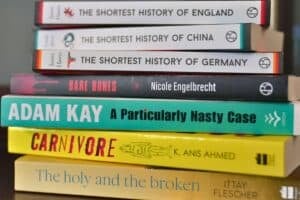Children's author Dianne Hofmeyr (pictured) is an inveterate traveller and note-taker, sourcing many of the ideas for her picture books and tween novels while away from home, armed with only her camera and notebook. There's a school of thought that suggests that travelling widely and reading as much as you can removes the need to go to school in the traditional sense.

“That’s a lovely philosophy,” says Hofmeyr. “As a small girl, I was taken all over South Africa and Zimbabwe. I can tangibly remember the Zimbabwe Ruins and the Victoria Falls I can even smell the dry trees. And I think the nuances I picked up as a child have remained; they’re the direct result of those early travels.”
Children don’t buy books. What are the challenges when writing for that audience; of marketing your work to two or three (parents and grandparents as well as the little ones) different generations? “Put the book in a library that makes it easy,” says Hofmeyr, sidestepping the issue by using commendable common sense.
“A good librarian will put the right book in the right hands. It’s the same with booksellers. There’s a shortfall in big cities where readers have no relationship with their booksellers and the way books are displayed is often quite bizarre.” Regardless of how the book gets to its target, though, how can authors combat the competition for attention from things such as computer games and social media?
“With The Name Of The Tree Is Bojabi,” says Hofmeyr, citing her latest picture book for youngsters, “I act it out for kids. The kids roar and get involved.
“That can’t be done with all books, of course. There’s humour here and that always helps. It’s important that the adult reading the book with the child is entertained as well. I think that writers, as adults, subconsciously insert the sort of detail that makes that possible. And an astute illustrator will add their own side-story.”
Writing for children requires making less of more taking a potentially complicated idea and distilling it into a handful of sentences per page.
“My working process for picture books is different than with novels,” says Hofmeyr. “I write with pencil and paper, and put the first draft together in a day. Then I put it away for a while. Over time, it gets shortened and changed. If it gets accepted for publication and the illustrator does the first dummy, it’s easy to re-cut they’ve done most of your work for you.”
Is there a similar filter for the novels?
“No,” smiles Hofmeyr, “I’m not that organised. “I don’t plan a novel. I rely on feelings and pictures; different things are going through my head all day long. It takes longer finding the ending this way than if you plan it before starting and there’s more rewriting needed, but I find it works.”
With all her travelling, journal-keeping and picture-taking, is there a future for Hofmeyr as a Bill Bryson or Paul Theroux-style writer for adults? “No,” she states.
“I’m drawn to reading their material, but I could never put myself in their place. I don’t have the gumption to write something on that scale.”








